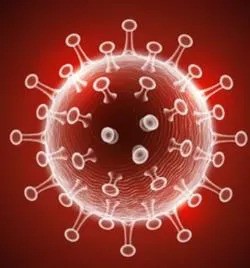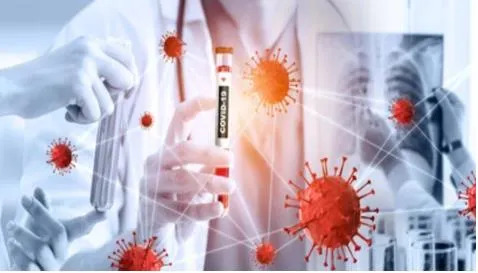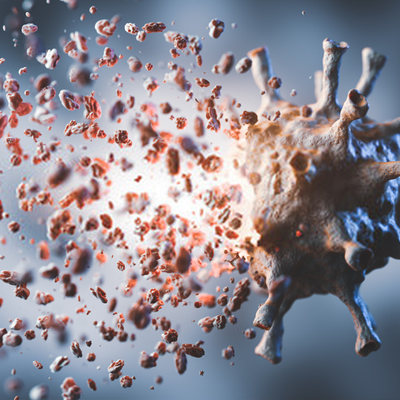COVID-19 DRUG RAW MATERIALS
Coronavirus disease 2019 (COVID-19) caused by severe acute respiratory syndrome coronavirus-2 (SARS-CoV-2, a single, positive-strand RNA virus) ) has rapidly become a global pandemic. It can affect your upper respiratory tract (sinuses, nose, and throat) or lower respiratory tract (windpipe and lungs). It spreads the same way other coronaviruses do, mainly through person-to-person contact. Infections range from mild to deadly.

Several medications have been approved to treat mild to moderate COVID-19 in people who are more likely to get very sick. As a socially responsible company, US Chemfine is committed to the research of COVID-19 raw materials. Hope the following review will help you understand more about COVID-19.
Structure and Pathogenesis of SARS-CoV-2
Genomic structure of the SARS-CoV-2 virus is shown in figure 1[1]. The spike (S) protein is a homo-trimeric protein mainly with two subunits, S1 and S2. S1 protein is involved in the formation of the receptor-binding domain, and S2 proteins produce the stem or stalk of the spike. The membrane (M) protein, as the most abundant transmembrane glycoprotein among all other proteins in virus particles, forms the shape of the envelope of the virus. The envelope (E) protein, as the smallest structural protein, is necessary for organizing the assembly of virion particles and its release (budding). The nucleocapsid (N) protein is essential for the packaging of the viral genome during the assembly step of the viral life cycle by binding to nonstructural protein 3.
The SARS-CoV-2 virus targets the multiciliated cells in the nasopharynx or trachea, or sustentacular cells in the nasal olfactory mucosa during natural infection in humans. After entry, the positive-sense SARS-CoV-2 genome directly initiates the production of viral proteins, including the replicase proteins that form replication factories from endoplasmic reticulum membranes. These replication factories contain double-membrane vesicles in which transcription occurs, shielding the double-stranded RNA (dsRNA) transcription intermediates from detection by cytoplasmic pattern recognition receptors (PRRs) (figure 2)[2].

Fig. 1 Genomic structure of the SARS-CoV-2 virus.
Treatments for COVID-19
The main treatments for COVID 19 include i) inhibiting the 3C-like (3CL) protease of coronavirus to inhibit the formation of virus, and ii) inhibiting RNA-dependent RNA polymerase (RdRp) to treat SARS-CoV-2 virus infections.

Fig. 2 Pathogenesis of SARS-CoV-2.
Inhibiting the 3CL protease
After entry, the viral RNA genome subjects the cell to translation of two large polyproteins, pp1a and pp1ab, which are processed into individual nonstructural proteins. 3CL protease is a cysteine protease responsible for cleaving 11 distinct sites of the polyproteins to transform into mature functional proteins. 3CL protease plays a critical role in viral replication, and its inhibition prevents the formation of replication-essential enzymes, thus inhibiting viral replication.

Inhibiting the RdRp
Within the RNA genome of infections is RdRp, which is a highly conserved viral protein that helps in RNA synthesis by catalyzing the RNA template-dependent development of phosphodiester bonds. Therefore, RdRp is an important therapeutic target in RNA virus-caused diseases, including SARS-CoV-2[3]. There are two main types of RdRp inhibitors, nonnucleoside inhibitors (NNIs, binding to the RdRp protein at allosteric sites) and nucleoside inhibitors (Nis, binding to the RdRp protein at the enzyme active site). In recent years, drugs by inhibiting the RdRp are booming for COVID-19 treatment.
US Chemfine is a professional supplier of COVID-19 drug raw materials. For high quality products, custom synthesis, professional technical service, and use suggestion, please feel free to contact us.

References
Sania Aamir, Iqra Mir, Muhammad Shahid, et al. Insights into the Structure, Replication, and Pathogenesis of the Severe Acute Respiratory Syndrome Coronavirus 2. Re:GEN Open.Jan 2022.85-92.
Lamers, M.M., Haagmans, B.L. SARS-CoV-2 pathogenesis. Nat Rev Microbiol 20, 270–284 (2022).
Tian, L., Qiang, T., Liang, C., Ren, X., Jia, M., Zhang, J., … Liu, H. RNA-dependent RNA polymerase (RdRp) inhibitors: The current landscape and repurposing for the COVID-19 pandemic. European Journal of Medicinal Chemistry, 2021, 213, 113201.